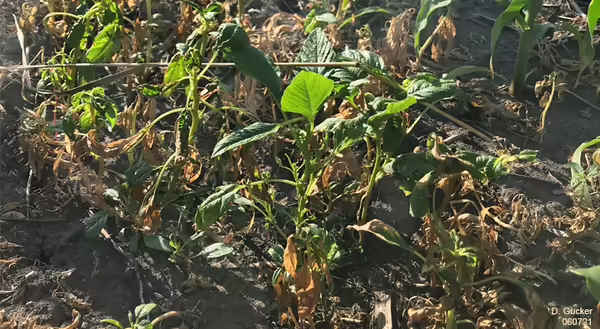
This is the third year in a row that I have seen tall waterhemp, over 6" tall, sprayed with a post-emergent herbicide combination containing dicamba. Last year, I noticed a few fields where it seemed that tall waterhemp had survived a late application of dicamba and appeared to have small seed heads.
Is this the beginning of dicamba herbicide-resistant weeds?
In 2019, University of Tennessee weed scientist Dr. Larry Steckel saw more escape pigweeds in fields where dicamba had been sprayed. Steckel suspected this was the beginning of dicamba resistance development as he had seen earlier with glyphosate.
The above picture was taken in Central Illinois two weeks after a post-emergence herbicide tank-mix that included dicamba. I, too, am wondering if I am seeing the beginning of dicamba resistance locally. If that happens, how are we going to control the tall waterhemp and other pigweeds in our corn and soybean rotations?
In Illinois, we currently have tall waterhemp resistant to seven different herbicide sites of action groups – 2, 4, 5, 9, 14, 15, and 27. These affected herbicide groups include the following commonly used herbicides: glyphosate, atrazine, cyanazine, Callisto, Dual, Laudis, 2, 4-D, Impact, Reflex, Outlook, Classic, and the list goes on.
There are no new herbicide modes of action being developed.
What is the answer to preventing dicamba herbicide resistance?
We are running out of herbicides that will control tall waterhemp and the other pigweeds. If you want to keep having dicamba as an effective herbicide to control pigweeds in Illinois, attack tall waterhemp and the other pigweeds with an integrated weed management program for your farming operation.
What does that look like? It involves using all the weed control methods available to you – cultural, mechanical, and chemical.
Integrated Weed Management plan
- Plant in a weed-free field Use mechanical weed control methods. And yes, they do make 24-row cultivators.
- Rotate your herbicides. Do not make more than two consecutive applications of herbicides with the same mode of action. Use herbicide tank mixes with modes of effective action.
- Rotate crops. Small grains and forage crops are very effective in reducing pigweed populations.
- Clean your equipment when moving from one field to another. Tillage tools and combines carry weed seeds from one field to another